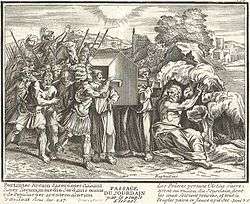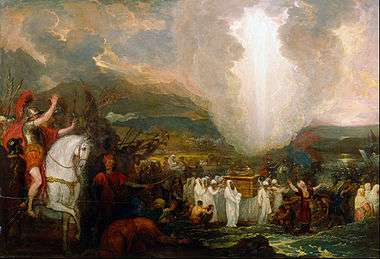Yom HaAliyah
| Yom HaAliyah יום העלייה | |
|---|---|
 Joshua Leading the Israelites Across the Jordan on 10th of Nisan | |
| Official name | Yom HaAliyah (Aliyah Day) Hebrew: יום העלייה |
| Observed by | State of Israel |
| Significance | Celebrating Aliyah as a core value of the Jewish People and honoring the ongoing contributions of Olim to Israeli society. On the tenth of the Hebrew month of Nisan according to the Bible, Joshua and the Israelites crossed the Jordan River at Gilgal into the Promised Land. |
| Begins | Nisan 10 (Hebrew calendar) & Observed in schools Cheshvan 7 (Hebrew calendar) |
| Date | 10 Nisan & Observed in schools 7 Cheshvan |
| 2017 date |
Sunset, 5 April – nightfall, 6 April[1] (hist.) Sunset, 26 October – nightfall, 27 October[2] (obs.) |
| 2018 date |
Sunset, 25 March – nightfall, 26 March (hist.) Sunset, 15 October – nightfall, 16 October (obs.) |
| 2019 date |
Sunset, 14 April – nightfall, 15 April (hist.) Sunset, 4 November – nightfall, 5 November (obs.) |
| 2020 date |
Sunset, 3 April – nightfall, 4 April (hist.) Sunset, 24 October – nightfall, 25 October (obs.) |
| Frequency | Annual |
Yom HaAliyah (Aliyah Day) (Hebrew: יום העלייה) is an Israeli national holiday celebrated annually on the tenth of the Hebrew month of Nisan and also observed in schools on the seventh of the Hebrew month of Cheshvan, to commemorate the historic events of the Jewish People entering the Land of Israel as written in the Bible, which happened on the tenth of the Hebrew month of Nisan (Hebrew: י' ניסן).[3] The holiday was established to acknowledge Aliyah, immigration to the Jewish state, as a core value of the State of Israel, and honor the ongoing contributions of Olim ("Jewish immigrants") to Israeli society.[4]
History

Yom HaAliyah, as a modern holiday celebration, began in 2012 as a grassroots community initiative and young Olim movement in Tel Aviv, spearheaded by the TLV Internationals organization of the Am Yisrael Foundation.[5] On June 21, 2016 the Twentieth Knesset voted in favor of codifying the grassroots initiative into law by officially adding Yom HaAliyah to the Israeli national calendar.[6] The Yom HaAliyah bill[7] was co-sponsored by Knesset members from different parties in a rare instance of cooperation across the political spectrum of the opposition and coalition.[8] Among those who worked on the Yom HaAliyah bill were Miki Zohar of Likud, Hilik Bar of Israeli Labor Party, and Michael Oren of Kulanu.[9] Similar bills were proposed in other failed forms by Members of Knesset in previous Knesset sessions; Yoel Razvozov, Robert Ilatov, Avraham Neguise, Gila Gamliel, and Ya'akov Katz.[10]
Significance
The original day chosen for Yom HaAliyah, the tenth of Nisan, is laden with symbolism. Although a modern holiday created by the Knesset of Israel, 10 Nisan is a date of Jewish religious significance referred to in the Bible. On that day, according to the biblical narrative in the Book of Joshua, Joshua and the Israelites crossed the Jordan River at Gilgal into the Promised Land while carrying the Ark of the Covenant. It was thus the first documented "mass Aliyah." On that day God commanded the Israelites to commemorate and celebrate the occasion by erecting twelve stones with the text of the Torah engraved upon them. The stones represented the entirety of the Jewish nation's twelve tribes and their gratitude for God's gift of the Land of Israel (Hebrew: אֶרֶץ יִשְׂרָאֵל, Modern Eretz Yisrael, Tiberian ʼÉreṣ Yiśrāʼēl) to them. [11] That date is also significant as it was the first Shabbat HaGadol that took place five days before the Israelites left Egypt beginning The Exodus. This is also the date that Moses's sister Miriam died and according to the Biblical narrative her well that miraculously traveled with the Israelites through the desert dried up. (Numbers, 20:1,2). [12][13]
Aliyah (US: /ˌæliˈɑː/, UK: /ˌɑː-/; Hebrew: עֲלִיָּה, "ascent") is the immigration of Jews from the diaspora to the Land of Israel. Also defined as "the act of going up", "making Aliyah" by moving to the Land of Israel is one of the most basic tenets of Judaism and therefore Zionism.[14] The State of Israel's Law of Return gives Jews and their descendants automatic rights regarding residency and Israeli citizenship.
Aliyah is an important Jewish religious concept and a fundamental component of Zionism. For much of Jewish history most Jews have lived in the diaspora where Aliyah was developed as a national aspiration for the Jewish people. It is enshrined in Israel's Law of Return, which accords any Jew (deemed as such by halakha and/or Israeli secular law) the legal right to assisted immigration and settlement in Israel, as well as Israeli citizenship.
Someone who "makes Aliyah" is called an "Oleh" (m.; pl. "Olim") or "Olah" (f.; pl. "Olot"). Many religious Jews espouse Aliyah as a return to the Promised land, and regard it as the fulfillment of God's biblical promise to the descendants of the Hebrew patriarchs Abraham, Isaac, and Jacob. Nachmanides (the Ramban) includes making Aliyah in his enumeration of the 613 commandments.[15]
In the Talmud, at the end of tractate Ketubot, the Mishnah says: "A man may compel his entire household to go up with him to the Land of Israel, but may not compel one to leave." The discussion on this passage in the Mishnah emphasizes the importance of living in Israel: "One should always live in the Land of Israel, even in a town most of whose inhabitants are idolaters, but let no one live outside the Land, even in a town most of whose inhabitants are Israelites; for whoever lives in the Land of Israel may be considered to have a God, but whoever lives outside the Land may be regarded as one who has no God."
Sifre says that the mitzvah (commandment) of living in Eretz Yisrael is as important as all the other mitzvot put together. There are many mitzvot such as shmita, the sabbatical year for farming, which can only be performed in Israel.[16]
According to the traditional Jewish ordering of books of the Tanakh (Old Testament), the very last word of the last book in the original Hebrew (2 Chronicles 36:23) is veya‘al, a jussive verb form derived from the same root as "Aliyah", meaning "and let him go up" (to Jerusalem in the Land of Israel).[17]
As the tenth of Nisan occurs a few days before the Passover holiday, when Israeli schools are not in session, the school system will also honor Aliyah on the seventh of the Hebrew month of Cheshvan. That date is also symbolic as the Torah portion read out in synagogues that week, Lekh Lekha, relates the story of how the biblical patriarch Abraham is ordered by God to leave his home and his family and go up to the Land of Israel. This is also the day that the additional prayer for rain is added into the Amidah, and recited 3 times a day by Jews in Israel.[18]
Jay M. Shultz President of the Am Yisrael Foundation, the driving force behind the creation of Yom HaAliyah [19], believes that the holiday will enable Jews "to connect the Biblical historical truth of Joshua crossing the Jordan to our modern practical reality...especially when Jews worldwide are celebrating Passover, and remembering the Exodus, they should take to heart that the final destination of leaving Egypt was entering the Land of Israel. The oft repeated phrase 'L'Shana Haba'ah B'Yerushalayim - Next Year in Jerusalem' should not be said in vain. There has never been an easier time in history for a Jew to live in Israel. It is time for every Jew to come Home." [20]
See also
- Public holidays in Israel
- Culture of Israel
- Jewish holidays
- Gathering of Israel
- Atchalta De'Geulah
- Return to Zion
- Jewish diaspora
- Homeland for the Jewish people
- Pre-Modern Aliyah
- Proto-Zionism
- L'Shana Haba'ah B'Yerushalayim
- Aliyah
- Zionism
- Israel
- Land of Israel
- Law of Return
- Israeli Nationality Law of 1952
- Hebrew calendar
- Nisan
- List of observances set by the Hebrew calendar
- History of the Jews and Judaism in the Land of Israel
References
- ↑ Hebrew/Gregorian calculations by
{{Hebrew year}}– via{{Calendar date}}} - ↑ Hebrew/Gregorian calculations by
{{Hebrew year}}– via{{Calendar date}}} - ↑ "Government to pass new holiday: 'Aliyah Day'". Ynetnews. Retrieved 2017-04-23.
- ↑ "Knesset Proposes Aliyah Holiday Bill". Israel National News. Retrieved 2017-04-23.
- ↑ "Yom HaAliyah: They made a day for us!". JNS.org. Retrieved 2017-04-23.
- ↑ "New national holiday in Israel". J-Wire. 2016-06-21. Retrieved 2017-04-23.
- ↑ "חוק יום העלייה – ויקיטקסט". he.wikisource.org. Retrieved 2016-11-08.
- ↑ Klein, Steven (2016-06-24). "Rank and File: Aliyah Day Becomes Official Holiday". Haaretz. Retrieved 2017-04-23.
- ↑ "Israel approves holiday to celebrate contribution of immigrants". Jewish News. Retrieved 2017-04-23.
- ↑ http://www.jpost.com/Jewish-World/Jewish-News/Bill-seeks-to-establish-national-Aliya-Day-345758
- ↑ "Yehoshua - Joshua - Chapter 4". www.chabad.org. Retrieved 2017-04-23.
- ↑ Tervanotko, Hanna K. (2016). Denying Her Voice: The Figure of Miriam in Ancient Jewish Literature. Vandenhoeck & Ruprecht. p. 257. ISBN 9783647551050.
- ↑ van den Bosch, Jan Williem (2016). "Chapter 13 The Well of Miriam and its Mythological Forbears". In Houtman, Alberdina; Kadari, Tamar; Poorthuis, Marcel; Tohar, Vered. Religious Stories in Transformation: Conflict, Revision and Reception. BRILL. ISBN 9789004334816.
- ↑ ""Aliyah": The Word and Its Meaning". 2005-05-15. Archived from the original on 2009-12-19. Retrieved 2013-04-29.
- ↑ Golinkin, David. "Is It A Mitzvah To Make Aliyah?". Responsa in a Moment. Schechter Institute of Jewish Studies. Retrieved 9 October 2012.
- ↑ Leff, Barry. "The Mitzvah of Aliyah". www.kefintl.com. Archived from the original on 27 December 2013. Retrieved 26 December 2013.
- ↑ "ץראב םתושרתשהו א"רגה ידימלת". ץראב םתושרתשהו א"רגה ידימלת. Daat. 2008-08-02.
- ↑ "Barech Aleinu". Halachipedia. Retrieved 27 October 2017.
- ↑ "Jay M. Shultz President of the Am Yisrael Foundation".
- ↑ "Haaretz - Aliyah Day Becomes Official Holiday".